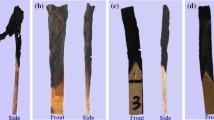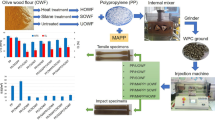Abstract
In this paper, the influence of melamine polyphosphate (MPP) and aluminum hypophosphite (AHP) on mechanical properties, flame retardancy and thermal degradation of high-density polyethylene/wood flour composites (HDPE/WF) was investigated. The synergistic effect of MPP and AHP was investigated. Polyethylene grafted with maleic anhydride (PE-g-MAH) was used as coupling agent. The experimental data demonstrated that the HDPE/WF composites with 35 wt% MPP/AHP (3:2) could achieve a LOI value of 29.6 % and UL-94 V-0 rating. In addition, the cone value also revealed that the heat release rate and the smoke production rate were clearly reduced. SEM results showed that the synergistic system (MPP/AHP = 3:2) could form a dense and thick char layer and good adhesion between wood flour and HDPE matrix, which prevented the transfer of heat flux and fuel gases. Incorporation of MPP and AHP improved the thermal stability of HDPE/wood flour as observed from the thermogravimetric analysis results and also enhanced the thermal resistance of char layer at high temperature based on scanning electron microscopy observation.




Similar content being viewed by others
References
Ayrilmis N, Akbulut T, Dundar T, White RH, Mengeloglu F, Buyuksari U (2012) Effect of boron and phosphate compounds on physical, mechanical, and fire properties of wood–polypropylene composites. Constr Build Mater 33:63–69
Bai G, Guo CG, Li LP (2014) Synergistic effect of intumescent flame retardant and expandable graphite on mechanical and flame-retardant properties of wood flour-polypropylene composites. Constr Build Mater 50:148–153
Bhattacharjee S, Sazzad MH, Islam MA, Ahtashom MM, Miah MYA (2013) Effects of fire retardants on jute fiber reinforced polyvinyl chloride/polypropylene hybrid composites. Int J Mater Sci Appl 2:162–167
Bledzki AK, Letman M, Viksne A, Rence L (2005) A comparison of compounding processes and wood type for wood fibre—PP composites. Compos Part A 36:789–797
Braun U, Schartel B (2008) Flame retardancy mechanisms of aluminium phosphinate in combination with melamine cyanurate in glass-fibre-reinforced poly(1,4-butylene terephthalate). Macromol Mater Eng 293(3):206–217
Braun U, Schartel B, Fichera MA, Jäger C (2007) Flame retardancy mechanisms of aluminium phosphinate in combination with melamine polyphosphate and zinc borate in glass-fiber reinforced polyamide 6,6. Polym Degrad Stab 92:1528–1545
Chen XL, Yu J, Guo SY (2006) Structure and properties of polypropylene composites filled with magnesium hydroxide. J Appl Polym Sci 102(5):4943–4951
Chiu SH, Wang WK (1998) The dynamic flammability and toxicity of magnesium hydroxide filled intumescent fire retardant polypropylene. J Appl Polym Sci 67:989–995
Garcia M, Hidalgo J, Garmendia I, Garcia-Jaca J (2009) Wood-plastics composites with better fire retardancy and durability performance. Compos Part A 40:1772–1776
Guo W, Li LP (2016) Preparation and property of melamine polyphosphate and aluminium hypophosphite flame-retardant and HDPE/wood flour composites. New Chem Mater 44(2):105–107 (In Chinese)
Kandem DP, Jiang H, Cui W, Freed J, Matuana LM (2004) Properties of wood plastics composites made of recycled HDPE and wood flour from CCA-treated wood removed from service. Compos Part A 35:347–355
Killaris P, Papaspyrides CD, Xalter R, Plaendner R (2012) Study on the properties of polyamide 6 blended with melamine polyphosphate and layered silicates. Polym Degrad Stab 97:1114–1122
Lenza J, Merkel K, Rydarowski H (2012) Comparison of the effect of montmorillonite, magnesium hydroxide and a mixture of both on the flammability properties and mechanism of char formation of HDPE composites. Polym Degrad Stab 97:25–81
Lewin M, Weil ED (2001) Mechanism and modes of action in flame retardancy of polymers. In: Horrocks AR, Price D (eds) Fire retardant materials. Woodhead Publishing Limited, Cambridge, pp 31–68
Li B, He JM (2004) Investigation of the mechanical property, flame retardancy and thermal degradation of LLDPE–wood fiber composites. Polym Degrad Stab 83:241–246
Liu WD, Chen TT, Wen XY, Renhui Qiu, Zhang XC (2014) Enhanced mechanical properties and water resistance of bamboo fiber-unsaturated polyester composites coupled by isocyanatoethyl methacrylate. Wood Sci Technol 48:1241–1255
Lorenzetti A, Besco S, Hrelja D, Roso M, Gallo E, Schartel B, Modesti M (2013) Phosphinates and layered silicates in charring polymers: the flame retardancy action in polyurethane foams. Polym Degrad Stab 98:2366–2374
Mederic P, Le Pluart L, Aubry T, Madec PJ (2013) Structure and rheology of polyethylene/imidazolium-based montmorillonite nanocomposites. J Appl Polym Sci 127:879–887
Migneault SB, Koubaa A, Erchiqui F, Chaala A, Englund K, Wolcott MP (2011) Application of micromechanical models to tensile properties of wood-plastic composites. Wood Sci Technol 45:521–532
Min K, Yang B, Miao JB et al (2013) Thermorheological properties and thermal stability of polyethylene/wood composites. J Macromol Sci Part B Phys 52:1115–1127
Modesti M, Lorenzetti A, Besco S, Hrelja D, Semenzato S, Bertani R, Michelin RA (2008) Synergism between flame retardant and modified layered silicate on thermal stability and fire behaviour of polyurethane nanocomposite foams. Polym Degrad Stab 93:2166–2171
Peng B, Wu H, Bao W, Gou S, Chen Y, Huang H et al (2011) Effects of ultrasound on the morphology and properties of propylene-based plastomer/nanosilica composites. Polym J 43:91–96
Sain M, Park SH, Suhara F, Law S (2004) Flame retardant and mechanical properties of natural fibre-PP composites containing magnesium hydroxide. Polym Degrad Stab 83:363–367
Salemane MG, Luyt AS (2006) Thermal and mechanical properties of polypropylene wood powder composites. J Appl Polym Sci 100:4173–4180
Seefeldt H, Braun U (2011) Burning behavior of wood-plastic composite decking boards in end-use conditions: the effects of geometry, material composition, and moisture. J Fire Sci 30:41–54
Stark N, White R, Mueller S, Osswald T (2010) Evaluation of various fire retardants for use in wood flour-polyethylene composites. Polym Degrad Stab 95:1903–1910
Thirumal M, Khastgir D, Singha NK, Manjunath BS, Naik YP (2008) Effect of expandable graphite on the properties of intumescent flame-retardant polyurethane foam. J Appl Polym Sci 110:2586–2594
Wei Y, Lei S, Yuan H, Lu HD, Yuen RKK (2011) Enhancement of fire retardancy performance of glass-fibre reinforced poly(ethylene terephthalate) composites with the incorporation of aluminum hypophosphite and melamine cyanurate. Compos Part B Eng 42:1057–1065
Wu NJ, Li XT (2014) Flame retardancy and synergistic flame retardant mechanisms of acrylonitrile-butadiene-styrene composites based on aluminum hypophosphite. Polym Degrad Stab 105:265–276
Yan YW, Huang JQ, Guan YH, Ke S, Jian RK, Wang YZ (2014) Flame retardance and thermal degradation mechanism of polystyrene modified with aluminum hypophosphite. Polym Degrad Stab 99:35–42
Yang W, Hu Y, Tai QL, Lu HD, Song L, Yuen RKK (2011a) Fire and mechanical performance of nanoclay reinforced glass-fiber/PBT composites containing aluminum hypophosphite particles. Compos Part A 42:794–800
Yang W, Song L, Hu Y, Lu HD, Yuen RKK (2011b) Enhancement of fire retardancy performance of glass-fibre reinforced poly (ethylene terephthalate) composites with the incorporation of aluminum hypophosphite and melamine cyanurate. Compos Part B 42:1057–1065
Zhou L, Gou CG, Li LP (2011) Influence of ammonium polyphosphate modified with 3-(methylacryloxyl) propyltrimethoxy silane on mechanical and thermal properties of wood flour-polypropylene composites. J Appl Polym Sci 22:849–855
Acknowledgments
This work was financially supported by Program for New Century Excellent Talents in University (NCET-13-0710) and the National Natural Science Foundation of China (31570572).
Author information
Authors and Affiliations
Corresponding author
Rights and permissions
About this article
Cite this article
Li, L., Guo, W. & Guo, C. Synergistic effect of melamine polyphosphate and aluminum hypophosphite on mechanical properties and flame retardancy of HDPE/wood flour composites. Wood Sci Technol 51, 493–506 (2017). https://doi.org/10.1007/s00226-016-0877-2
Received:
Published:
Issue Date:
DOI: https://doi.org/10.1007/s00226-016-0877-2




